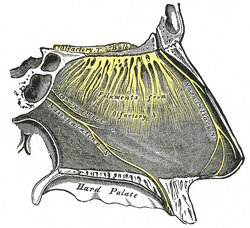| Nerve: Olfactory nerve | ||
|---|---|---|
| [[Image:{{{Image2}}}|250px|center|]] | ||
| {{{Caption2}}} | ||
| Latin | nervus olfactorius | |
| Gray's | subject #196 | |
| Innervates | ||
| From | ||
| To | ||
| MeSH | A08.800.800.120.640 | |
The olfactory nerve, or cranial nerve I, is the first of twelve cranial nerves. The specialized olfactory receptor neurons of the olfactory nerve are located in the olfactory mucosa of the upper parts of the nasal cavity. The olfactory nerve consists of a collection of sensory nerve fibers that extend from the olfactory epithelium to the olfactory bulb, passing through the many openings of the cribriform plate, a sieve-like structure.
Olfactory receptor neurons continue to be born throughout life and extend new axons to the olfactory bulb. Olfactory ensheathing glia wrap bundles of these axons and are thought to facilitate their passage into the central nervous system.
The sense of smell (olfaction) arises from the stimulation of the olfactory receptors by activation from gas molecules that pass by the nose during respiration. The resulting electrical activity is transduced into the olfactory bulb which then transmits the electrical activity to other parts of the olfactory system and the rest of the central nervous system via the olfactory tract.
The olfactory nerve is the shortest of all the twelve cranial nerves and only one of two cranial nerves (the other being the optic nerve) that do not join with the brainstem.
To test the function of the olfactory nerve, doctors block one of the patient's nostrils and place a pungent odour (such as camp coffee essence) under the open nostril. The test to see if the patient can detect the smell is then repeated on the other nostril.
External links
Sensory system: Olfactory system / Olfaction / Rhinencephalon (TA 15.1, GA 10.992) | |
|---|---|
| Olfactory epithelium | |
| Olfactory nerve: 1° neuron |
Olfactory receptor neurons (Olfactory receptor) → Olfactory bulb (Glomeruli) |
| Olfactory nerve: 2° neuron | |
| Lateral olfactory stria/ Primary olfactory cortex |
Piriform cortex · EC-hippocampus system (Entorhinal cortex, Hippocampal formation) · Prepyriform area · Periamygdaloid cortex Stria medullaris → Habenular nuclei |
| Medial olfactory stria | |
| Template:Olfaction navs | |
de:Nervus olfactorius fr:Nerf olfactif lt:Uoslės nervas nl:Nervus olfactorius zh:嗅神經
| This page uses Creative Commons Licensed content from Wikipedia (view authors). |
